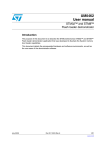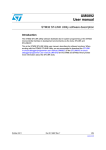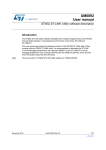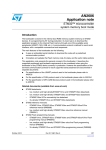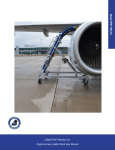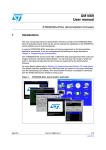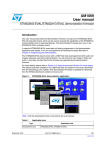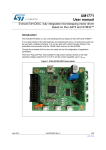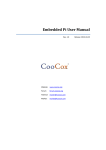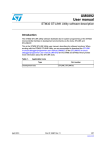Download STM32F101xx, STM32F102xx and STM32F103xx Flash
Transcript
UM0462
User manual
STM32F101xx, STM32F102xx and STM32F103xx
Flash loader demonstrator
Introduction
The purpose of this document is to describe the STMicroelectronics STM32F101xx,
STM32F102xx and STM32F103xx Flash loader demonstrator application that was
developed to illustrate the System memory bootloader capabilities.
This document details the prerequested hardware and software environments, as well as
the use cases of the demonstrator software.
October 2008
Rev 4
1/19
www.st.com
Contents
UM0462
Contents
1
Getting started . . . . . . . . . . . . . . . . . . . . . . . . . . . . . . . . . . . . . . . . . . . . . . 4
1.1
Package contents . . . . . . . . . . . . . . . . . . . . . . . . . . . . . . . . . . . . . . . . . . . . 4
1.1.1
Software contents . . . . . . . . . . . . . . . . . . . . . . . . . . . . . . . . . . . . . . . . . . 4
1.1.2
Hardware contents . . . . . . . . . . . . . . . . . . . . . . . . . . . . . . . . . . . . . . . . . . 4
1.2
System requirements . . . . . . . . . . . . . . . . . . . . . . . . . . . . . . . . . . . . . . . . . 4
1.3
Flash loader demonstrator installation . . . . . . . . . . . . . . . . . . . . . . . . . . . . 6
1.3.1
Software installation . . . . . . . . . . . . . . . . . . . . . . . . . . . . . . . . . . . . . . . . . 6
1.3.2
Hardware installation . . . . . . . . . . . . . . . . . . . . . . . . . . . . . . . . . . . . . . . . 6
2
User interface description . . . . . . . . . . . . . . . . . . . . . . . . . . . . . . . . . . . . 7
3
Command-line usage . . . . . . . . . . . . . . . . . . . . . . . . . . . . . . . . . . . . . . . 15
4
Revision history . . . . . . . . . . . . . . . . . . . . . . . . . . . . . . . . . . . . . . . . . . . 18
2/19
UM0462
List of figures
List of figures
Figure 1.
Figure 2.
Figure 3.
Figure 4.
Figure 5.
Figure 6.
Figure 7.
Figure 8.
System Properties dialog box . . . . . . . . . . . . . . . . . . . . . . . . . . . . . . . . . . . . . . . . . . . . . . . . 5
Device Manager window. . . . . . . . . . . . . . . . . . . . . . . . . . . . . . . . . . . . . . . . . . . . . . . . . . . . 6
Connection settings page . . . . . . . . . . . . . . . . . . . . . . . . . . . . . . . . . . . . . . . . . . . . . . . . . . . 8
Flash status page . . . . . . . . . . . . . . . . . . . . . . . . . . . . . . . . . . . . . . . . . . . . . . . . . . . . . . . . . 9
Device information page . . . . . . . . . . . . . . . . . . . . . . . . . . . . . . . . . . . . . . . . . . . . . . . . . . . 10
Operation choice page . . . . . . . . . . . . . . . . . . . . . . . . . . . . . . . . . . . . . . . . . . . . . . . . . . . . 12
Option byte edition page . . . . . . . . . . . . . . . . . . . . . . . . . . . . . . . . . . . . . . . . . . . . . . . . . . . 13
Operation progress page . . . . . . . . . . . . . . . . . . . . . . . . . . . . . . . . . . . . . . . . . . . . . . . . . . 14
3/19
Getting started
UM0462
1
Getting started
1.1
Package contents
The following items are supplied in the Flash loader demonstrator package:
1.1.1
1.1.2
Software contents
1.
STBLLIB.dll: a dynamic link library implementing the system memory bootloader
protocol and the COM communication APIs.
2.
Files.dll: a dynamic link library implementing the needed file manipulation APIs to load
and store binary, hexadecimal and motorola S19 files.
3.
STMicroelectronics Flash loader.exe: a wizard application that provides the high-level
operations that can be performed by the user.
4.
STMFlashLoader.exe: a command-line version of the STMicroelectronics Flash
loader.exe that provides the same features over several options.
5.
The “Map” directory is located in the installation directory. It contains the mapping
description files of the supported devices.
6.
The “Src” directory is located in the installation directory. It contains the header and Lib
files of the two DLLs and the complete source of the command-line version.
7.
The “Doc” directory is located in the installation directory, it contains the UM0462 and
UM0516 (Windows API for STMicroelectronics microcontroller bootloaders) user
manuals.
Hardware contents
The Flash loader demonstrator is designed to work with all STMicroelectronics devices that
support the system memory boot mode protocols. For more details, please visit the
STMicroelectronics website (http://www.st.com) and refer to the application note AN2606:
“STM32F101xx and STM32F103xx system memory boot mode”.
1.2
System requirements
In order to use the Flash loader demonstrator with the Windows operating system, a recent
version of Windows, such as Windows 98, Millennium, 2000, XP or Vista, must be installed
on the PC.
The version of the Windows OS installed on your computer may be determined by rightclicking on the “My Computer” icon on the desktop, then clicking on the “Properties” item in
the displayed pop-up menu. The OS type is displayed in the “System Properties” dialog box
under the “System” label as shown in Figure 1.
4/19
UM0462
Getting started
Figure 1.
System Properties dialog box
For the communication, you need to verify that you have an available COM port(RS232) as
one COM port is required for system connection.
To check that you have an available communication port, right-click on the “My Computer”
icon on the desktop and select “Properties” from the pop-up menu. The “System Properties”
dialog box appears. Click on the “Hardware” tab, and then on the “Device manager” button
to display the system hardware configuration. Available COM ports are grouped under the
“Ports (COM & LPT)” node in the hardware tree as shown in Figure 2.
5/19
Getting started
Figure 2.
UM0462
Device Manager window
It is interesting to know the capabilities of the COM port. To find out, right click on the
Communication Port (COMx) item then click on “Properties” to display the Properties
window. Select the “Port Settings” tab, then click on the arrow next to the “Bits per second”
combo box to know the baud rates supported by the port.
1.3
Flash loader demonstrator installation
1.3.1
Software installation
If an older version is installed on you computer, remove it by using the “Add or Remove
Programs” service in the “Control Panel”.
Run the Flash_Loader_Demonstrator_V1.2_Setup.exe file: the InstallShield Wizard will
guide you through the installation of the Flash loader demonstrator application on your
computer. Once the software has been successfully installed, click on the “Finish” button.
1.3.2
Hardware installation
Connect the device to a spare COM port on your PC.
6/19
UM0462
2
User interface description
User interface description
The Flash loader demonstrator is designed as a wizard application. It is structured into six
steps, the:
1.
Connection settings page
2.
Flash status page
3.
Device information page
4.
Operation choice page
5.
Option byte edition page
6.
Operation progress page
Step 1
Run the Flash loader demonstrator application from the “Programs” menu (connection to the
device has not been made yet) then, make sure that the device is connected to your PC and
reset it to restart the system memory bootloader code.
This step consists in selecting the connection settings. Select the desired UART settings
(port name, baud rate and timeout) as shown in Figure 3. For an optimum configuration, set
“Baud Rate” to 57600 bits per second and the “Timeout(s)” to 5 seconds.
Ensure that the boot configuration pins are set correctly, then click “Next” to continue. If a
connection has been established, the wizard moves to the next step, otherwise a message
box is displayed that indicates the error that occurred.
Possible errors messages:
Note:
●
“Cannot open the COM port”: this message is shown if the selected COM port is not
found or if it is already being used by another process.
●
“Unrecognized device”: this message is shown if the received value is different from
79h. Resetting the device may solve the problem.
●
“No response from the target”: this message is shown when there is no response from
the target. It indicates that the System memory boot loader is not functional. Verify the
boot configuration and check that the used microcontroller contains the boot loader
code.
The Timeout argument is the period of time after which a read request from the serial port is
aborted if no data is received. The recommended value is 5 seconds, but it depends on the
used environment, like the hardware performance.
7/19
User interface description
Figure 3.
8/19
Connection settings page
UM0462
UM0462
User interface description
Step 2
In the second step the connection has been established and communication has started. It
consists in displaying the Flash memory status. This status can be read-protected, in which
case the “Next” button is disabled until the read protection is removed by clicking on the
“Remove protection” button.
Note:
Clicking on the “Remove protection” button will not only read-unprotect the Flash memory, it
will also erase all its pages.
Figure 4.
Flash status page
9/19
User interface description
UM0462
Step 3
In this step the Wizard displays the available device information such as the target ID, the
firmware version, the supported device, the memory map and the memory protection status.
Select the target name in the target combobox as shown in Figure 5, then click on “Next” to
continue.
Figure 5.
10/19
Device information page
UM0462
User interface description
Step 4
At this step, select the requested operation –Erase, Download, Upload or Disable/Enable
Flash protection or Edit option bytes – and set the related parameters:
1.
2.
3.
Erase
a)
Choose “All” to erase the whole memory
b)
Choose “Selection” to customize the Erase operation. Click the “...” button to
display the memory mapping dialog window. Then check the pages to be erased
and click “Ok”.
Download
–
Click the related browse button to open a binary, hexadecimal or S19 Motorola file.
If the loaded file is a binary file, the download address is the start address of the
first page and the “@” field is still editable to accept changes.
If the loaded file is a hexadecimal or an S19 motorola file, the download address is
the start address of the first record in the file, and the “@” field is read-only.
–
Check the “Verify” check box to launch the verification process when the
Download operation is finished.
–
Check “Jump to the user program” to launch the downloaded program.
–
Check “Optimize” to filter FFs packets (256 bytes).
–
Check “Apply option bytes”, then browse the option byte file created by the “Edit
option bytes” operation. The values in the selected file will be applied to the device
after download.
Upload
–
4.
Disable/Enable Flash protection
–
5.
Click the related browse button to select which binary, hexadecimal or S19
motorola file will store the uploaded data.
Select the choices from the two drop-down menus to make up the desired
command (Enable Read protection, Disable Read protection, Enable Write
protection, Disable Write protection). All protection commands will be applied to all
the Flash memory pages except for the Enable Write Protection, which can be
customized. This is done by clicking the “...” button to select the pages to be writeprotected.
Edit option bytes
–
If you need to set the option bytes, check the option then click “Next” to move to
the option byte edition page (Step 5 Figure 7.).
Warning:
Erase and Download operations can be performed only if the
write protection is disabled.
11/19
User interface description
Figure 6.
UM0462
Operation choice page
Step 5
The last Wizard page depends on the operation selected in Step 4.
a)
Case of an “Edit option bytes” operation:
The Option byte edition page is displayed. It contains the current option byte values
loaded from the device: RDP, USER, Data0, Data1, WRP0, WRP1, WRP2 and WRP3.
For more details, please refer to the Option byte loader section in the “STM32F10xxx
Flash programming manual” (PM0042 available from www.st.com).
This step gives the possibility of applying the edited option byte values, loading them
from the device and saving them to a file.
12/19
UM0462
User interface description
Figure 7.
b)
Option byte edition page
Case of any other operation:
The operation page is shown. It gives the size of the data to be downloaded or
uploaded, the percent completed and the duration of the operation as illustrated in
Figure 8.
●
If the operation is successful, the progress bar is green colored. If an error occurs, the
bar turns red and the error is displayed.
●
To stop the operation click the “Cancel” button.
●
If the “Jump to the user program” check box was checked in the previous step (Step 4),
and the user program was successfully downloaded, communication with the system
memory boot loader is lost. Consequently, the “Back” button is redirected to the
“Connection settings page” (Step 1) to avoid the launch of a new operation.
If the “Jump to the user program” check box was not checked in Step 4, the “Back”
button is still active and you can return to Step 4 and select a new operation.
13/19
User interface description
Figure 8.
14/19
Operation progress page
UM0462
UM0462
3
Command-line usage
Command-line usage
The command-line version (STMFlashLoader.exe) provides the same functionality as the
GUI. It supports several options in order to run a sequence of operations.
The following paragraphs describe the available command-line options.
STMFlashLoader.exe option [Arguments] [option [Arguments]]...
-?
Shows help.
-c:
Defines the COM port.
The -c option allows you to select the COM port that the command uses to communicate
with the target MCU. By default, the command uses COM1. To select different COM port
and connection settings, use the -c option in the form:
-c --pn port_number (e.g 1, 2..., default 1)
-c --br baud_reate (e.g 115200, 57600..., default 57600)
-c --db data_bits (value in {5,6,7,8}..., default 8)
-c --pr parity (value in {NONE,ODD,EVEN}..., default EVEN)
-c --sb stop_bits (value in {1,1.5,2}..., default 1)
-c --to time_out ((ms) e.g 1000, 2000, 3000..., default 5000)
The -c option supports multiple arguments. This means that you can set more than one
argument in the same command:
-c --pn 1 --br 115200 --to 7000
-i device_name
Defines the MCU target to be used.
For example: STM32F10xxBxx, STM32F10xx8xx, STM32F10xx6xx. The device name is the
name of the map file located in the Map directory.
-e
Erase command.
According to the given arguments, the command can be used to erase a specific page of
memory or, to erase the entire Flash memory. This operation can take a second or more to
complete, depending on the memory size involved.
-e --all erase all pages
-e --sec number_of_pages_group pages_group_codes
-e --sec 3 0 1 2 erases 3 groups of pages coded 0, 1 and 2
15/19
Command-line usage
UM0462
-u
Uploads the Flash memory contents to the specified file (bin, hex or s19 file; the file type is
recognized by its extension), to specify a file use the -u option in the form:
-u --fn file_name (full path name)
-d
Downloads the contents of the specified file into the MCU Flash memory at the specified
address. To specify the file to be downloaded and the download address, use the -d option
in the form:
-d --a address(hex) --fn file_name (full path name (bin, hex or s19 file); the file type is
recognized by its extension).
The address is mandatory in the case of binary files and ignored in the case of hex and s19
files.
To verify the downloaded data, add the --v argument.
To optimize and remove FF packets, use the --o argument.
-o
Gets or sets option bytes.
Use --get to read option bytes from the device and store values to a file.
--get --fn file_name (full path name)
Use --set to write option bytes to the device. The option bytes can be read from a file or
given as values.
--set --fn file_name (full path name)
--set --vals --OPB hex_value (OPB in (User, RDP, Data0, Data1, WRP0, WRP1,
WRP2, WRP3).
The -o option can accept multiple arguments as shown below:
-o --get get_file_name --set set_file_name
-o --get get_file_name --set --vals --User 01 --RDP 5A --Data0 DE --Data1 EA
Warning:
16/19
When setting option bytes, if RDP is not equal to A5h, the
read protection is activated, and all subsequent operations
will fail.
UM0462
Command-line usage
-p
Activates or deactivates the protection. It is used as shown below:
-p --erp (Activate read protection)
-p --drp (Deactivate read protection)
-p --ewp number_of_pages_group pages_group_codes (activates the write protection
on the given page group codes)
-p --dwp (disables the write protection)
Warning:
The --erp argument activates the read protection. All
subsequent operations will fail. To avoid this kind of problem,
use -p --erp as the last argument.
-r
Performs a jump to the specified address. It is used as follows:
-r --a address(hex)
Note:
Note that all command-line options found are executed IN ORDER. Thus, with a careful
arrangement of the command-line options, you can perform a complicated sequence of
operations.
17/19
Revision history
4
UM0462
Revision history
Table 1.
18/19
Document revision history
Date
Revision
Changes
25-Oct-2007
1
Initial release.
05-Jun-2008
2
Flash loader demonstrator version upgraded to V1.1.
Small text changes.
Section 1.1.1: Software contents updated. Section 1.2: System
requirements modified.
Welcome step removed, Flash status page and Option byte edition
page added.
Section 3: Command-line usage added.
Step 2 on page 9 added. Step 5 on page 12 modified.
17-Jun-2008
3
Software revision updated in Section 1.3.1: Software installation on
page 6.
31-Oct-2008
4
Flash loader demonstrator version upgraded to V1.2. It can also be
used with STM32F102xx devices.
Figure 3 to Figure 8 updated accordingly.
UM0462
Please Read Carefully:
Information in this document is provided solely in connection with ST products. STMicroelectronics NV and its subsidiaries (“ST”) reserve the
right to make changes, corrections, modifications or improvements, to this document, and the products and services described herein at any
time, without notice.
All ST products are sold pursuant to ST’s terms and conditions of sale.
Purchasers are solely responsible for the choice, selection and use of the ST products and services described herein, and ST assumes no
liability whatsoever relating to the choice, selection or use of the ST products and services described herein.
No license, express or implied, by estoppel or otherwise, to any intellectual property rights is granted under this document. If any part of this
document refers to any third party products or services it shall not be deemed a license grant by ST for the use of such third party products
or services, or any intellectual property contained therein or considered as a warranty covering the use in any manner whatsoever of such
third party products or services or any intellectual property contained therein.
UNLESS OTHERWISE SET FORTH IN ST’S TERMS AND CONDITIONS OF SALE ST DISCLAIMS ANY EXPRESS OR IMPLIED
WARRANTY WITH RESPECT TO THE USE AND/OR SALE OF ST PRODUCTS INCLUDING WITHOUT LIMITATION IMPLIED
WARRANTIES OF MERCHANTABILITY, FITNESS FOR A PARTICULAR PURPOSE (AND THEIR EQUIVALENTS UNDER THE LAWS
OF ANY JURISDICTION), OR INFRINGEMENT OF ANY PATENT, COPYRIGHT OR OTHER INTELLECTUAL PROPERTY RIGHT.
UNLESS EXPRESSLY APPROVED IN WRITING BY AN AUTHORIZED ST REPRESENTATIVE, ST PRODUCTS ARE NOT
RECOMMENDED, AUTHORIZED OR WARRANTED FOR USE IN MILITARY, AIR CRAFT, SPACE, LIFE SAVING, OR LIFE SUSTAINING
APPLICATIONS, NOR IN PRODUCTS OR SYSTEMS WHERE FAILURE OR MALFUNCTION MAY RESULT IN PERSONAL INJURY,
DEATH, OR SEVERE PROPERTY OR ENVIRONMENTAL DAMAGE. ST PRODUCTS WHICH ARE NOT SPECIFIED AS "AUTOMOTIVE
GRADE" MAY ONLY BE USED IN AUTOMOTIVE APPLICATIONS AT USER’S OWN RISK.
Resale of ST products with provisions different from the statements and/or technical features set forth in this document shall immediately void
any warranty granted by ST for the ST product or service described herein and shall not create or extend in any manner whatsoever, any
liability of ST.
ST and the ST logo are trademarks or registered trademarks of ST in various countries.
Information in this document supersedes and replaces all information previously supplied.
The ST logo is a registered trademark of STMicroelectronics. All other names are the property of their respective owners.
© 2008 STMicroelectronics - All rights reserved
STMicroelectronics group of companies
Australia - Belgium - Brazil - Canada - China - Czech Republic - Finland - France - Germany - Hong Kong - India - Israel - Italy - Japan Malaysia - Malta - Morocco - Singapore - Spain - Sweden - Switzerland - United Kingdom - United States of America
www.st.com
19/19



















